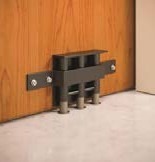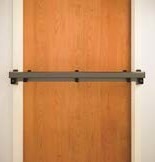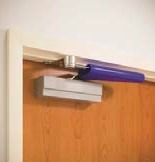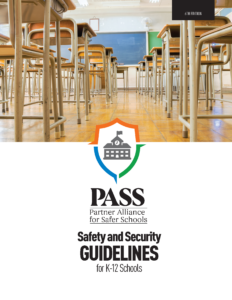5 Reasons Schools Should Avoid Classroom Barricade Devices
Following high-profile attacks on our nation’s schools, it’s instinctive to want to do everything possible that could protect students and teachers from being in the line of fire; however, the need to act urgently, combined with limited information and available funding, can lead to choices that may solve one problem but inadvertently create others. It’s now more important than ever that school officials be able to distinguish needed, effective and code compliant solutions from sales pitches on unnecessary products.
Protecting students and staff is a tremendous moral and legal responsibility that requires a multifaceted approach. While no single solution will make our schools safe, school safety experts and all the various government agencies, commissions and task forces that have examined these issues universally agree that it is essential that all classrooms can be locked from the inside as a basic protection for occupants in the event of an emergency.

Unfortunately, some products are being offered to K-12 schools in lieu of, or in addition to, proper classroom locks, based on the misconception that barricading the door is the only way to protect students and teachers in the classroom, and allegedly lower cost; however, most K-12 security experts and school safety organizations – including the Partner Alliance for Safer Schools (PASS) – oppose the use of “barricade devices,” also known as “door blockers” or “secondary locking devices,” for five critical reasons:

- Willful misuse of the devices can prevent both escape from inside the room and emergency response from the outside. What happens when the danger is in the room? If an emergency was taking place inside of a room barricaded with such devices, first responders would not be able to easily enter. Not only would the availability of these devices in a classroom present an everyday opportunity for misuse, but they could also be counterproductive during the potential active shooter events they are intended to address. There are many instances in which shooters barricaded themselves with hostages inside rooms or school buildings, including Virginia Tech, West Nickel Mines School, Platte Canyon and others.
- Most of these devices violate life safety code requirements for free egress and violate accessibility requirements under the Americans with Disabilities Act, which ensure that all occupants – regardless of ages and physical ability – can exit easily and without obstruction. Our life safety codes and accessibility laws have been developed over decades of experience and products that meet these code requirements have stringent test standards. There are no test standards for barricade devices.
- Classroom security locks already provide effective lockdown capability in a safe manner for students and school personnel. A secondary locking device is completely unnecessary. Throughout dozens of documented active shooter events at schools, there has been no instance in which a school attacker has bodily breached a locked classroom. PASS recommends using one of three basic types of mechanical locks for classrooms or electronic locks that provide the same functionality.
- Existing locksets or other door hardware can be upgraded at similar cost if required. Many older classroom locks still in use today require teachers to step outside of the room to lock the door, which is unacceptable from a security standpoint. To address this there are other low-cost options such as retrofit kits that change the lock function, providing the ability to lock the door from the inside in a code-compliant and effective manner.
- Increased Liability. For all these reasons, use of barricade devices could open communities and school districts to additional liability exposure, especially if a barricade device is utilized in the commission of a violent act.

Unfortunately, despite the risks associated with barricade devices, several states have or are considering legislation or code changes that provide a special exemption for their use. PASS urges that any changes to state policies on this matter be preceded by a thorough review of classroom security issues that examines all existing guidelines and life safety codes as well as commercially available products and services.
As noted, the PASS Safety and Security Guidelines for K-12 Schools recommend that all classrooms be equipped, at a minimum, with mechanical locks appropriate for the K-12 setting, and this should be accompanied by a policy that classroom doors should remain closed and locked when occupied.
Mechanical locks appropriate for the K-12 setting:
- Office function lockset: The outside lever can be set in a locked or unlocked position by a push button lock feature on the inside lever, allowing the door to be easily secured from inside the room. This is one of the most common choices due to the ease of use.
- Storeroom function lockset: The outside lever is always locked as a default position – so when the door is closed it is also locked. Storeroom locks do not require an additional action to secure the door but will always require authorized personnel to open the door with a key from the outside of the room if needed.
- Security classroom function lockset: The outside lever can be set in a locked or unlocked position by a key in the inside lever, allowing a teacher to secure the door from inside the room. Security function locks limit the locking of the door to personnel who have keys.
The choice among these lock types should consider the room’s normal occupants and intended use, a facility assessment, and relevant state laws or local code requirements.
Regardless of the lock type, classroom locks in the K-12 setting should meet the following criteria: (1) the ability to lock the outside lever from the inside of the room, (2) keyed or electronic access from the corridor side for access by authorized personnel, (3) free egress from the inside of the room with a single releasing motion and (4) a visual indicator to occupants of locked or unlocked condition.
The facts simply do not support the use of barricade devices. PASS urges school officials to consider only safe and proven options recommended for securing classrooms in the event of an emergency. For more details, see the PASS white paper on barricade devices.
Download the PDF version of this article.

Ready to get the Guidelines?
The most comprehensive information available on best practices specifically for securing school facilities, vetted extensively by experts across the education, public safety and industry sectors.
